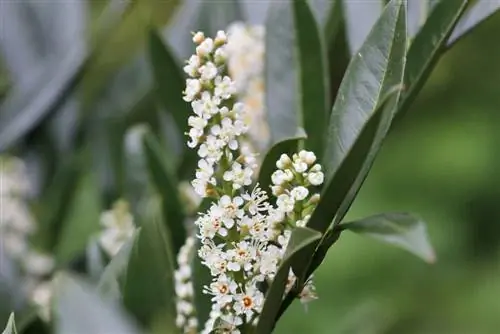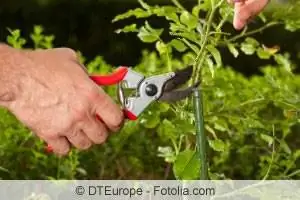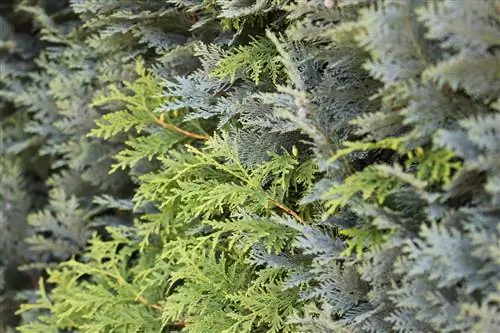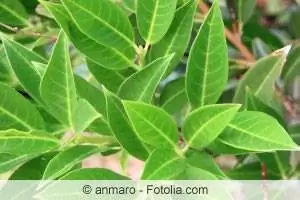- Author admin [email protected].
- Public 2023-12-17 03:39.
- Last modified 2025-01-24 12:45.
A bamboo hedge not only gives the garden a very special flair with an Asian touch, but can also serve as reliable protection against excessive sunlight, strong winds and unpleasant looks or even loud noise. Regardless, it is an inimitable spectacle when the bamboo seems to dance in the wind. Here you will find out everything you need to know about creating and caring for a bamboo hedge.
It may come as a surprise that bamboo is considered a grass. After all, its trunks can not only grow many meters high, but also reach an impressive diameter of a good 20 cm or more. It should be noted that such impressive trunk diameters are usually only found in the natural homelands of the incredibly decorative grasses. In this country, however, the diameter is usually less than eight centimeters, but this should be a clear advantage when it comes to creating a bamboo hedge in your home garden.
The Location
Bamboo generally prefers sandy to humus-rich soils that are as loose as possible. If necessary, they can also thrive in loamy soil, as long as it is not too compacted. In addition, the soil should be consistently moist. Consequently, at least during long dry periods and/or unusually hot summers, it may be advisable to water the bamboo hedge according to its needs. However, watering should not be so heavy that waterlogging could occur. Since the above-mentioned waterlogging can lead to rotting of the bamboo roots, it is also advisable to loosen up heavy clay soils by adding humus, potting soil or mature compost so that excess water can drain away or seep away better. Under certain circumstances, it might even be appropriate to put drainage into the ground before creating the bamboo hedge. Apart from that, the location should be relatively protected from the wind. Although even the strongest winds usually cannot harm the extremely flexible bamboo, it should be remembered that due to its enormous flexibility it can cause great damage if its shoots whip around driven by the wind. The lighting conditions that should exist at the location can vary greatly from type of bamboo to type of bamboo, which is why you should definitely find out more about this before buying bamboo or planting it.
The planting distance
The size of the planting distance depends primarily on the density that the bamboo hedge should achieve. It must be pointed out straight away that bamboo grows very quickly and can reach an impressive size, which is why the distance should not be too close, no matter how delicate the young plants to be planted may seem. Accordingly, it is generally recommended to plant two to a maximum of three plants per meter. Depending on the type of bamboo, the distance between the individual plants should be 70 to 100 cm. It should be noted that not only the distance between the plants, but also the distance to nearby buildings, fences and sidewalks etc. must not be set too close under any circumstances. In fact, in some federal states there are even relevant regulations that must be strictly adhered to. Basically, it can be said that the minimum distance depends directly on the height that the bamboo hedge should have from now on, especially since the individual bamboo stalks can lean to the side almost over their full length in rain and snow or strong winds.
Planting time
A bamboo hedge can be created from early spring to late autumn. However, there are several reasons for spring planting. The first reason is that if planted in spring, the bamboo hedge has a full growing season to establish itself in its new location. An aspect that is of overriding importance, especially with regard to the winter hardiness of the young bamboo hedge. In addition, the bamboo hedge does not need to be watered as heavily after planting as in the case of summer planting.
The Bamboo Planting
Before planting, the balls of bamboo roots should be completely immersed in water until no more air bubbles appear. During this time, the planting holes can be dug, which should be approximately twice as large as the root balls in terms of their depth and diameter. If necessary, the excavated soil with which the planting holes are then refilled can now be mixed with humus, compost or potting soil. Experts also recommend covering the bottom of the planting holes with a mixture of garden soil and granulated cow dung or well-seasoned cow manure before planting. Then the planting holes are filled with loose soil until the root balls of the young plants are flush with the surrounding garden soil. As soon as the bamboo plants have been placed in the garden, the planting holes are completely filled with soil. After the soil has been gently pressed under, it is watered until it begins to silt up. The aim of so-called sludging is, on the one hand, to provide the freshly planted bamboo hedge with optimal moisture. On the other hand, slurrying prevents air holes. Regardless of this, the roots can grow significantly better through slurrying.
Bamboo Care
Caring for a bamboo hedge is limited to watering as needed and annual topiary. With regard to watering, it should be noted that if in doubt, the evergreen bamboo hedge should also be watered throughout the winter, as long as it is not so cold that the bamboo roots are in danger of freezing. With regard to extensive pruning, it should be mentioned that this should, if possible, be done before new leaves emerge. However, smaller corrective cuts can also be made after the main shoots in spring and into early summer.
Tip:
Bamboo hedges should always be watered in the early morning or late evening, at least in midsummer, as it is then not so hot that a large part of the water can simply evaporate unused.
Frequently asked questions
Why could my bamboo have yellow leaves?
Yellow leaves can be an indication of waterlogging, which is why you should refrain from watering again for the time being. It may also be advisable to drain the soil so that excess water can drain away better.
The leaves on my bamboo hedge have suddenly curled up in winter. Is this normal or should I be worried?
Some types of bamboo tend to curl their leaves when there is a prolonged lack of water in order to minimize water loss through evaporation. Although this phenomenon is primarily observed in particularly hot summers, it can also occur in the winter months. As a result, you should water your bamboo hedge thoroughly, temperatures permitting.
Can I actually keep bamboo in pots?
Of course, you can also plant bamboo in sufficiently large pots. However, your bamboo will then need to be watered relatively often and may also need to be supplied with nitrogen-containing fertilizer.






